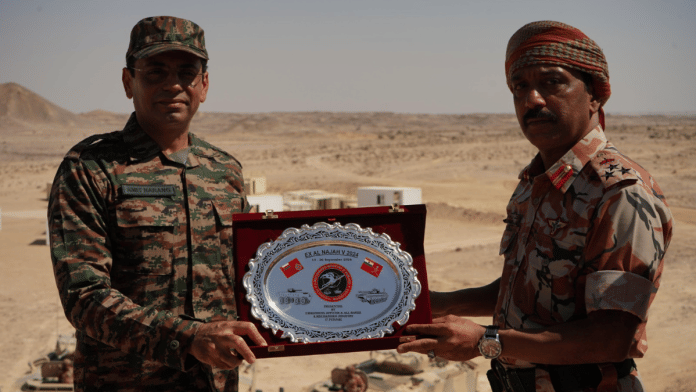New Delhi: The image of Indian ambassador to Oman Amit Narang wearing the Army combats at the closing ceremony of the joint military exercise Al Najah has generated controversy, with a section of veterans finding it to be disrespectful towards the armed forces.
In a post put up by Indian Army’s official ‘X’ handle, Narang is seen in the new combat uniform at the theatre of the military exercise that concluded 26 September. The new combat fatigues with digital print were introduced in 2022 and were inducted only last year. They are not available in the open market.
The consensus among the critical voices, which included journalists and military enthusiasts as well, was that the uniform of the Army officers and men were highly coveted given the Indian Army’s reputation of being a professional fighting force.
Only serving personnel can wear service uniforms of all three armed forces, they asserted.
Former BJP MP Rajeev Chandrashekhar was among those who questioned the gesture of the Indian envoy. “How is an [sic] Foreign Service Officer wearing an Indian Army Uniform? Is he a Territorial Army officer? If not, this is extremely irregular,” he posted on ‘X’.
The new combat fatigues, with digital print were introduced in 2022 and were inducted only last year. They are not available in the open market.
Most veterans, journalists and military enthusiasts on social media found the gesture to be disrespectful towards the Army.
Once the post was up on social media, it gained wide traction with a large number of people taking exception to the officer wearing the combat fatigues.
ThePrint reached out to the Indian Army for an official response. The response was not received till the time of publishing the report.
Also Read: Indigenous aircraft carrier INS Vikrant joins Navy’s Western Fleet, ready for deployment
What rules say
A military law expert told ThePrint that the Army Act, 1950, does not categorically prohibit the wearing of uniforms by civilians. He said that these were only combat fatigues without any rank badges or insignia.
However, according to Section 171 of the Indian Penal Code (IPC), “wearing garb or carrying token used by a public servant with fraudulent intent” is prohibited.
The law states that in case an individual who does not belong to a certain class of public servants, wears any garb or carries any token resembling the ones used by that particular class of public servants, with the intention of impersonating that particular class of public servants, shall be punished.
“To invoke IPC, it needs to be proved that the person wearing such uniform is doing so with the intention of making others believe that he belongs to that particular class of public servants. Merely wearing a uniform without such intention or knowledge is not an offence under the section,” the military law expert said.
Going by that logic, this expert said, the ambassador has not committed any offence.
The legal expert, however, said that it might not be in good taste and may not be ethical but “it was not illegal and certainly not an offence”.
‘Disrespectful to Army’
But, veterans of the armed forces ThePrint reached out to expressed their displeasure and asserted that the Army uniform was earned and was not a prop to be used during photo sessions.
“Absolutely unbecoming. The diplomat should not have worn the uniform. As per military protocols, the uniform is not to be used by anyone except the personnel,” Major General Yash Mor (retired) told ThePrint, expressing “surprise”.
Major General Rambir Mann (retired) asserted that wearing military or army uniform by a diplomat was a violation of diplomatic norms and protocol, as ambassadors represented their nations in civil capacity.
“It can lead to perceptions of militarisation in diplomatic relations, which is contrary to principles of neutrality that the office is expected to uphold,” he said, adding that such actions can create misunderstanding about India’s diplomatic mission in the region.
However, the positive aspect is that this gesture can be seen as supportive of the ongoing defence cooperation between India and Oman, he added.
A retired Lieutenant General asserted that the rules must be laid in black and white as to who can wear the uniform, on what occasion, and who cannot. “If the Prime Minister can wear it, why can’t bureaucrats wear it?” he said.
In recent times, he said, the Army camouflages were being copied even by the paramilitary forces.
The retired officer added that military practices were slowly percolating to not just the paramilitary but also the police. “If the prime minister could lead the whole show wearing the fatigues, why stop anyone else? It’s now becoming a habit.”
(Edited by Tony Rai)
Also Read: A fitness & fighter aircraft enthusiast, who is Air Marshal AP Singh, the next Chief of Air Force






